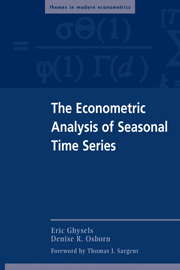Book contents
- Frontmatter
- Contents
- Foreword by Thomas J. Sargent
- Preface
- List of Symbols and Notations
- 1 Introduction to Seasonal Processes
- 2 Deterministic Seasonality
- 3 Seasonal Unit Root Processes
- 4 Seasonal Adjustment Programs
- 5 Estimation and Hypothesis Testing with Unfiltered and Filtered Data
- 6 Periodic Processes
- 7 Some Nonlinear Seasonal Models
- Epilogue
- Bibliography
- Subject Index
- Author Index
3 - Seasonal Unit Root Processes
Published online by Cambridge University Press: 05 June 2012
- Frontmatter
- Contents
- Foreword by Thomas J. Sargent
- Preface
- List of Symbols and Notations
- 1 Introduction to Seasonal Processes
- 2 Deterministic Seasonality
- 3 Seasonal Unit Root Processes
- 4 Seasonal Adjustment Programs
- 5 Estimation and Hypothesis Testing with Unfiltered and Filtered Data
- 6 Periodic Processes
- 7 Some Nonlinear Seasonal Models
- Epilogue
- Bibliography
- Subject Index
- Author Index
Summary
Introduction
The two previous chapters have introduced seasonal unit root processes and considered some of their implications. In particular, Chapter 2 discussed the special case of a seasonal random walk process, showing it to consist of S independent random walk processes with one of these processes attached to each of the seasons of the year.
It is now well known that a series generated by a unit root process can wander widely and smoothly over time without any inherent tendency to return to its underlying mean value; see, for example, Granger (1986). In the seasonal context, there are S unit root processes, none of which has an inherent tendency to return to a deterministic pattern. As a result, the values for the seasons can wander widely and smoothly in relation to each other, making any underlying relationship between the expected values for the different seasons effectively irrelevant in practice. It is often remarked that, in the presence of seasonal unit roots, summer can become winter.
The immediately following section explores the implications of seasonal unit root processes in more detail, before the discussion moves on to consider tests of the unit root hypothesis in Sections 3.3–3.5. The analysis is extended to seasonal cointegration in Section 3.6. Some of the discussion of this chapter is quite technical, which is the nature of material dealing with the asymptotics of nonstationary processes. Our aim, however, is to make the material as accessible as possible and to draw together strands of recent research in this area.
- Type
- Chapter
- Information
- The Econometric Analysis of Seasonal Time Series , pp. 42 - 92Publisher: Cambridge University PressPrint publication year: 2001



